
Newport News Shipbuilding (NNS), a division of Huntington Ingalls Industries, is the sole designer, builder, and refueler of aircraft carriers and one of two providers of submarines for the United States Navy. Founded as the Chesapeake Dry Dock and Construction Co. in 1886, Newport News Shipbuilding has built more than 800 ships, including both naval and commercial ships. Located in the city of Newport News, its facilities span more than 550 acres (2.2 km2).
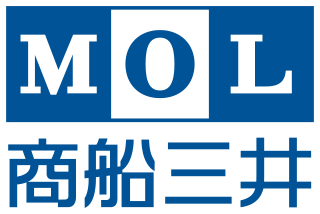
Mitsui O.S.K. Lines is a Japanese transport company headquartered in Toranomon, Minato, Tokyo, Japan. It is one of the largest shipping companies in the world.

A cargo ship or freighter is a merchant ship that carries cargo, goods, and materials from one port to another. Thousands of cargo carriers ply the world's seas and oceans each year, handling the bulk of international trade. Cargo ships are usually specially designed for the task, often being equipped with cranes and other mechanisms to load and unload, and come in all sizes. Today, they are almost always built of welded steel, and with some exceptions generally have a life expectancy of 25 to 30 years before being scrapped.
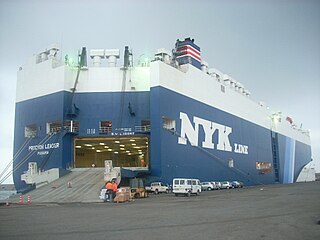
Roll-on/roll-off ships are cargo ships designed to carry wheeled cargo, such as cars, motorcycles, trucks, semi-trailer trucks, buses, trailers, and railroad cars, that are driven on and off the ship on their own wheels or using a platform vehicle, such as a self-propelled modular transporter. This is in contrast to lift-on/lift-off (LoLo) vessels, which use a crane to load and unload cargo.

Wallenius Lines is a privately owned Swedish shipping company. The company was founded in 1934 by Olof Wallenius. Wallenius Lines is an investor and active owner within the global shipping industry, specifically the international car and roll-on/roll-off segment.

Wallenius Wilhelmsen Logistics was a privately owned Norwegian/Swedish shipping company, established in 1999 and co-owned by the two shipping companies Wallenius Lines and Wilh. Wilhelmsen.
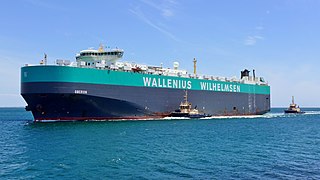
Wallenius Wilhelmsen is a Sweden/Norway-based global RoRo shipping and vehicle logistics company, managing the distribution of cars, trucks, rolling equipment, Mafi trailers and breakbulk globally.
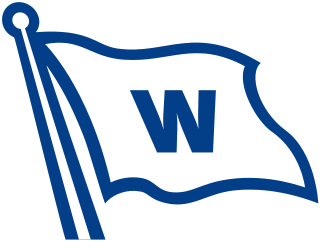
Wilh. Wilhelmsen Holding ASA (WWH) is a Norwegian multinational maritime group, headquartered in Lysaker, Norway. The group employs more than 21,000 people and has operations in 75 nations. The Wilhelmsen group operates the largest maritime network in the world, with over 2200 locations worldwide.
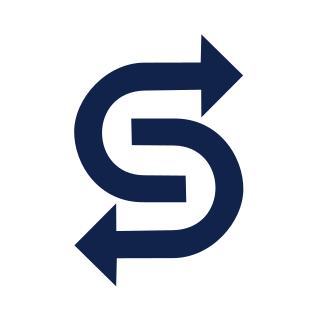
Seatrain Lines, officially the Over-Seas Shipping Company, was a shipping and transportation company conducting operations in the Americas and trans-Pacific regions. Seatrain Lines began intermodal freight transport in December 1928 by transporting entire loaded railroad freight cars between the United States and Cuba. The specially designed ship Seatrain, built in England, was followed in 1932 by two larger ships built in the United States and in 1939 by two additional ships. By the outbreak of World War II the company was operating five ships that became important in the war effort and basis for the design of fifty new ships for military use. A series of business setbacks amid the rise of containerized shipping left the company in perilous financial condition in the 1970s. Seatrain Lines shut down in 1981 after filing for bankruptcy.

Sun Shipbuilding & Drydock Company (1917–1989) was a major shipbuilding company in Chester, Pennsylvania on the Delaware River.

MV Taiko was a roll-on/roll-off (RoRo) freighter managed by the Norwegian-Swedish shipping line Wallenius Wilhelmsen Logistics. She was built as Barber Hector by Hyundai Heavy Industries at Ulsan, South Korea in 1984 for Blue Funnel Line, part of the Liverpool company Ocean Transport & Trading Ltd, and was Blue Funnel's last newbuilding. She was deployed on Barber Blue Sea Line, a joint venture between Blue Funnel, Wilh. Wilhelmsen, Oslo and the Broström Group of Sweden. In 1988 Ocean withdrew from Barber Blue Sea line and Barber Hector was sold to the Swedish partner, chartered to Wilhelmsen and renamed Taiko. Wilhelmsen purchased the vessel in 1993.

Trans-Asia Shipping Lines, Incorporated (TASLI) is a shipping company based in Cebu City, Philippines. It was incorporated on March 25, 1974, under the name of Solar Shipping Lines, Inc. The Chairman of the company is Dennis A. Uy. Trans-Asia Shipping Lines is now managed by the Chelsea Logistics, Corp.

Danny F II was a cargo ship built in 1975 as a car carrier. She was renamed Danny F II when rebuilt as a livestock transporter in 1994. The ship capsized and sank off Lebanon on 17 December 2009, carrying 83 people, 10,224 sheep, and 17,932 cattle. 40 people were rescued and 11 found dead. The other crew, passengers and animals are presumed to have died.

Atlantic Container Line is an American, previously Swedish, shipping company owned by the Italian Grimaldi Group. The company operates large roll-on/roll-off (RORO) container ships between Europe and North America.
The Type C7 ship(Lancer Class) is a United States Maritime Administration (MARAD) designation for a cargo ship and the first US purpose-built container ship. The vessels were constructed in US shipyards and entered service starting in 1968. As US-built ships they were Jones Act qualified for shipments between US domestic ports. Under the Jones Act, domestic US maritime trade is restricted to US-built and flagged vessels of US owners and manned by predominantly US-citizen crews. The last active Lancer container-configured ship was scrapped in 2019. Lancers of the vehicle Roll-on/Roll-off (RO/RO) configuration remain held in the Ready Reserve Force, National Defense Reserve Fleet and the US Navy Military Sealift Command. All are steam powered.
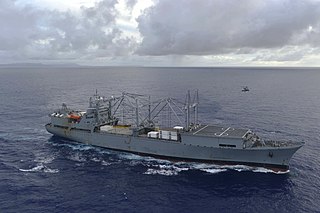
The Type C5 ship is a United States Maritime Administration (MARAD) designation for World War II breakbulk cargo and later a container ship for containerization shipments. The first type C5-class ship was a class of ships constructed and produced in the United States during World War II. The World War II C5-class ship was dry bulk cargo ship built by Bethlehem Steel in Sparrows Point, Maryland. Bethlehem Steel built eight ships in this bulk cargo class and four orders were canceled. The C5-class ship has a 24,250 DWT and was 560 feet (170 m) long. The C5 was mainly used as iron ore carriers. The C5 was needed to replace other ships that sank during World War II. First in her class was SS Venore, USMC #1982, delivered on 20 July 1945. The Type C5-class ship designed to fill the need to move iron ore from Santa Cruz, Chile, to Sparrows Point, Maryland, through the Panama Canal, a round-trip of 8,700 nautical miles . Post World War II, four ships were given C5 class type C5-S-78a, these were roll-on/roll-off container ship built by Ingalls Shipbuilding, Inc. of Pascagoula, Mississippi and operated by the Moore-McCormack Lines. The C5-S-78a had a deadweight tonnage of 16,000 tons.

American Roll-on Roll-off Carrier is an American shipping line specialized in Roll-on/roll-off worldwide sea carriage.
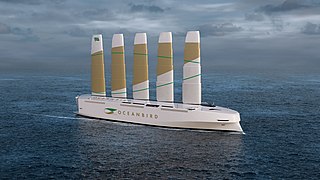
Oceanbird is a concept for wind-powered cargo vessels under development by Wallenius Marine. The concept aims to lower emissions by up to 90 percent and the design was developed in collaboration with KTH Royal Institute of Technology and Swedish maritime technology company SSPA. Financial backing for the development was provided by the Swedish Transport Agency. In 2021, Wallenius announced a partnership with Swedish heavy industry company Alfa Laval to further develop the concept's wingsail design.
Wallenius Marine is a ship design and ship management company in Sweden. Headquartered in Stockholm, the company has additional offices in Singapore and employs some 800 people.

















